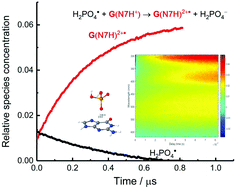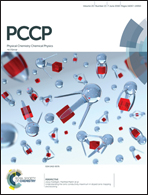Direct observation of the oxidation of DNA bases by phosphate radicals formed under radiation: a model of the backbone-to-base hole transfer†
Abstract
In irradiated DNA, by the base-to-base and backbone-to-base hole transfer processes, the hole (i.e., the unpaired spin) localizes on the most electropositive base, guanine. Phosphate radicals formed via ionization events in the DNA-backbone must play an important role in the backbone-to-base hole transfer process. However, earlier studies on irradiated hydrated DNA, on irradiated DNA-models in frozen aqueous solution and in neat dimethyl phosphate showed the formation of carbon-centered radicals and not phosphate radicals. Therefore, to model the backbone-to-base hole transfer process, we report picosecond pulse radiolysis studies of the reactions between H2PO4˙ with the DNA bases – G, A, T, and C in 6 M H3PO4 at 22 °C. The time-resolved observations show that in 6 M H3PO4, H2PO4˙ causes the one-electron oxidation of adenine, guanine and thymine, by forming the cation radicals via a single electron transfer (SET) process; however, the rate constant of the reaction of H2PO4˙ with cytosine is too low (<107 L mol−1 s−1) to be measured. The rates of these reactions are influenced by the protonation states and the reorganization energies of the base radicals and of the phosphate radical in 6 M H3PO4.



 Please wait while we load your content...
Please wait while we load your content...